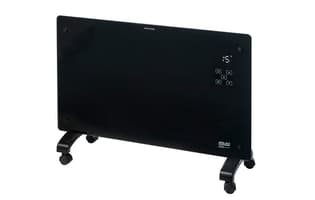Electric heaters
Find the best electric heater for your home with our buying guide and test results for 31 current and 19 discontinued models.
Here's how we test the latest electric heaters.
Lifetime score
Our overall score combines test performance (how well the appliance works and how easy it is to use) with predicted reliability (how likely models from the brand are to remain free of faults) and brand satisfaction (how satisfied owners of the brand are likely to be).
 We’ll only recommend appliances you’ll love to own, that work well and keep working well for a long time.
We’ll only recommend appliances you’ll love to own, that work well and keep working well for a long time.
Test performance
It’s no good if a product lasts for several decades if it doesn’t work well in the first place. A disappointing product will soon become unloved and unwanted. For this reason, our independent lab testing forms an important part of our overall lifetime score.
Our heaters test includes:
Performance
This is calculated on each heater’s ability to warm a room from 8°C to 13°C and from 8°C to 18°C, the evenness of the room heating and the thermostat’s performance. We test heaters in a special room fitted with 81 evenly spaced temperature sensors.
The temperature reading from the sensors enables us to create a 3D map of the effect each heater has. We look at the time the units take to heat the room, the evenness of the room’s temperature, and how well the thermostats keep the room at an even temperature.
Ease of use
For each heater, we assess using the controls, control labelling, cord storage, how easy it is to move the unit, and how easy it is to clean.
Running costs
The models in our test vary in wattage from 2000W to 2400W. The actual running cost of a heater is dependent on the type of heater, how well it heats your home and how often you use it. To help guide you in buying a heater we include an Estimated daily and Estimated monthly running cost. These figures are based on the power usage over 6 hours on maximum setting.
The better a heater is at heating a room, the lower the running cost. A model that performs well in our tests can likely be placed on a lower setting, use less power and therefore cost less to run.
Predicted reliability
It’s reasonable to expect a new appliance to remain fault-free for at least the first five years. Our predicted reliability won’t tell you whether your heater will stop working tomorrow, but it does show which brands make models that are less likely to fail.
Brand satisfaction
Satisfaction is important – no appliance should be a source of buyer regret. Appliances with very satisfied owners are more likely to be well maintained. Their owners are more inclined to seek repair for faults than look for a quick replacement.
Survey data 101
In our annual reliability and satisfaction survey, consumers tell us about faults that have made an appliance they own unusable or mean they’ve had to change how they use it. We also ask them how satisfied they are with the appliance. We use this data to produce our predicted reliability and brand satisfaction scores.
We use a statistical test to rate the relative performance of each brand. Compared to data we have for all products (of the same type) in the survey, we rate each brand with highest, high, average, low or lowest for each of reliability and satisfaction.
You can compare the rating of different brands for the same product type (for example, the reliability rating for Miele and Haier washing machines), but you can’t compare the results for different product types (for example, satisfaction of LG TVs and Samsung phones).
We analyse brands that get at least 30 responses in our survey. That means there are some brands we can’t analyse because we don’t have enough data. For those brands, we assume they have average predicted reliability and brand satisfaction.
Our data is based on responses for 1,317 electric heaters in our 2025 survey.
We've tested 50 electric heaters.
Find the right one for you.
Arlec

Atlantic

.jpg&w=315&q=75)